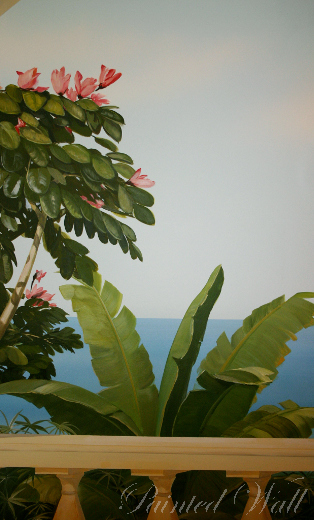Playing with Illusion and Reality
Painting that tempts the eye, that breaks through the boundaries of space and seems to integrate the furnishings playfully into an overall picture has been an occasion for edification and distraction for thousands of years.
Unlike transportable painting, wall painting is put directly on stone or plaster and therefore constitutes an architecture-bound art which is subject to rather specific formal principles.
Thus it may emphasize a wall's function as completion of a room, or else it can open up the interior towards the outside by an apparent dissolution of the wall.
The beginnings of wall painting lie in the upper palaeolithic and have been preserved in various caves in eg. North Africa and Spain, but also on the coastal rocks of Australia.
Temple walls in Mesopotamia, but also palaces on the river Euphrates have been decorated with wall paintings, and to this day the marvellous mural paintings in Egyptian tombs and palaces have not ceased to fascinate us.
In Crete and Mycenae, mainly wall paintings in fresco technique have outlasted the years.
The Babylonians and Assyrians decorated their temples with tempera colours.
Architectural painting as a means of design to achieve a three-dimensional illusion has first been employed in Hellenism and then carried on in the Roman decoration of living space (Pompeian wall painting).
Illusionistic wall painting reached its peak in the Renaissance.
Particulary Italian painters devoted themselves increasingly to the highly sophisticated art of illusionistic painting.
Among the masterpieces of this era are the mural paintings in fresco technique by Masaccio and Piero della Francesca.
In the baroque age, illusionistic wall painting reached new dimensions, since the formal demand was supplemented by a more content-orientated conception of art. Important representatives of this period are Piero da Cortona and Guercinos.
Since the actual deception of the viewer is achieved by a perspective calculation of the subject to be depicted and the effects of the light to which it is exposed, perfect illusionistic painting requires detailed studies of proportions and light incidence as well as a precise understanding of mathematical and physical laws. Thus, architectural parts seem to rise up high, sculptures radiate an authentic plasticity and massiveness and horizons extend into the depth.
A ceiling or wall painting is always a very time-consuming and expensive enterprise. Together with secco and tempera painting, the most popular method has been the fresco technique where pigments enter into an unseparable compound with the underground layer whilst drying, but which is rarely employed nowadays because of its costs.
For this purpose, the 20th century has developed colours on an acrylic basis which can be handled easily and which can be used to create wall paintings on facades as well as indoors without any problems.
The quality of these colours lies primarily in their high resistance which defies all all weathers and in their amazing light-fastness. Applying these colours, which generate a water-insoluble surface after drying, also ensures protection of the stonework. Therefore they are especially well suited for wall paintings in wet areas and on facades.
This - in the truest sense of the word - imperishable art form of illusionistic painting has many admirers today as well. Not only can their play with appearances and reality be an expression of their very individual way of decoration - it also gives in to the yearning for the ultimate borderless space.





